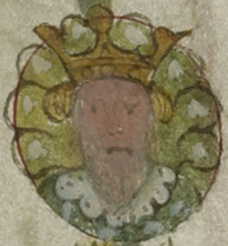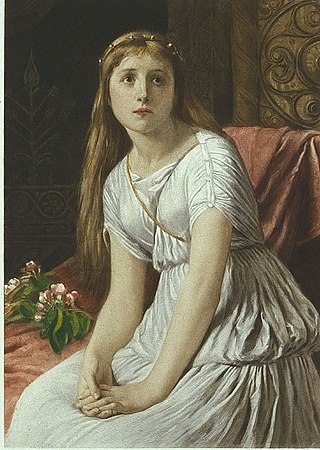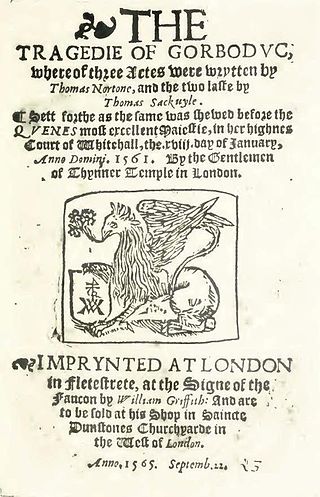
King Lear is a tragedy written by William Shakespeare. It is loosely based on the mythological Leir of Britain. King Lear, in preparation for his old age, divides his power and land between his daughters Goneril and Regan, who pay homage to gain favour, feigning love. The King's third daughter, Cordelia, is offered a third of his kingdom also, but refuses to be insincere in her praise and affection. She instead offers the respect of a daughter and is disowned by Lear who seeks flattery. Regan and Goneril subsequently break promises to host Lear and his entourage, so he opts to become homeless and destitute, and goes insane. The French King married to Cordelia then invades Britain to restore order and Lear's rule. In a subplot, Edmund, the illegitimate son of Gloucester, betrays his brother and father. Tragically, Lear, Cordelia and several other main characters die.

Titus Andronicus is a tragedy by William Shakespeare, believed to have been written between 1588 and 1593. It is thought to be Shakespeare's first tragedy and is often seen as his attempt to emulate the violent and bloody revenge plays of his contemporaries, which were extremely popular with audiences throughout the 16th century.

Brutus Greenshield was a legendary king of the Britons as accounted by Geoffrey of Monmouth. He was the son of King Ebraucus and came to power in 1001BC.

Leir was a legendary king of the Britons whose story was recounted by Geoffrey of Monmouth in his pseudohistorical 12th-century History of the Kings of Britain. According to Geoffrey's genealogy of the British dynasty, Leir reigned around the 8th century BC, around the time of the founding of Rome. The story was modified and retold by William Shakespeare in his Jacobean tragedy King Lear.

Cordelia was a legendary Queen of the Britons, as recounted by Geoffrey of Monmouth. She came to power in 855BC.
Marganus was a legendary king of the Britons as accounted by Geoffrey of Monmouth. He came to power in 850BC.
Cunedagius was a legendary king of the Britons, as recounted by Geoffrey of Monmouth. He came to power in 850BC.
Ferrex was the son of the legendary king Gorboduc of the Britons, and fought with his brother Porrex for the throne, according to Geoffrey of Monmouth.
Porrex I was a legendary king of the Britons as accounted by Geoffrey of Monmouth. He was the son of Gorboduc and his death began a dynastic civil war.
Dyfnwal Moelmud was accounted as an early king and lawmaker among the Welsh, credited with the codification of their standard units of measure. He also figures as a legendary king of the Britons in Geoffrey of Monmouth's pseudohistorical History of the Kings of the Britons.

Historia regum Britanniae, originally called De gestis Britonum, is a pseudohistorical account of British history, written around 1136 by Geoffrey of Monmouth. It chronicles the lives of the kings of the Britons over the course of two thousand years, beginning with the Trojans founding the British nation and continuing until the Anglo-Saxons assumed control of much of Britain around the 7th century. It is one of the central pieces of the Matter of Britain.

The Tragedie of Gorboduc, also titled Ferrex and Porrex, is an English play from 1561. It was first performed at the Christmas celebration given by the Inner Temple in 1561, and performed at Whitehall before Queen Elizabeth I on 18 January 1561, by the Gentlemen of the Inner Temple. The authors were Thomas Norton and Thomas Sackville, said to be responsible for the first three acts, and the final two, respectively.
Revenge tragedy is a theatrical genre, in which the principal theme is revenge and revenge's fatal consequences. Formally established by American educator Ashley H. Thorndike in his 1902 article "The Relations of Hamlet to Contemporary Revenge Plays," a revenge tragedy documents the progress of the protagonist's revenge plot and often leads to the demise of both the murderers and the avenger himself.

Holinshed's Chronicles, also known as Holinshed's Chronicles of England, Scotland, and Ireland, is a collaborative work published in several volumes and two editions, the first edition in 1577, and the second in 1587. It was a large, comprehensive description of British history published in three volumes.
Women in Shakespeare is a topic within the especially general discussion of Shakespeare's dramatic and poetic works. Main characters such as Dark Lady of the sonnets have elicited a substantial amount of criticism, which received added impetus during the second-wave feminism of the 1960s. A considerable number of book-length studies and academic articles investigate the topic, and several moons of Uranus are named after women in Shakespeare.

Goneril is a character in William Shakespeare's tragic play King Lear (1605). She is the eldest of King Lear's three daughters. Along with her sister Regan, Goneril is considered a villain, obsessed with power and overthrowing her elderly father as ruler of the kingdom of Britain.
Although traditionally Titus Andronicus has been seen as one of Shakespeare's least respected plays, its fortunes have changed somewhat in the latter half of the twentieth century, with numerous scholars arguing that the play is more significant and effective than has been acknowledged in most criticisms. In particular, scholars have argued that the play is far more thematically complex than has traditionally been thought, and features profound insights into ancient Rome, Elizabethan society, and the human condition. Such scholars tend to argue that these previously unacknowledged insights have only become apparent during the twentieth and twenty-first centuries due to newfound relevance in the play's ultraviolent content. For example, in his 1987 edition of the play for the Contemporary Shakespeare series, A.L. Rowse writes; "in the civilized Victorian age the play could not be performed because it could not be believed. Such is the horror of our own age, with the appalling barbarities of prison camps and resistance movements paralleling the torture and mutilation and feeding on human flesh of the play, that it has ceased to be improbable." Similarly, director Julie Taymor, who staged a production Off-Broadway in 1994 and directed a film version in 1999, says she was drawn to the play because she found it to be the most "relevant of Shakespeare's plays for the modern era." She feels that the play has more relevance for contemporary audiences than it had for the Victorians: "it seems like a play written for today, it reeks of now." Because of these newer appreciations of the play's relevance, previously unrecognized thematic strands have thus come to the forefront.

Titus Andronicus is the main character in William Shakespeare's revenge tragedy of the same name, Titus Andronicus. Titus is introduced as a Roman nobleman and revered general. Prior to the events of the play, he dedicated ten years of service in the war against the Goths, losing 21 sons in the conflict. In the opening act, Titus orders that the eldest son of Tamora, Queen of the Goths, be sacrificed according to Roman tradition in order to avenge his dead kin. He is also offered the emperorship, but he declines the honor and bestows it upon the late emperor's son, Saturninus. When Saturninus is denied the ability to pick his first choice of empress, Lavinia, he chooses to wed Tamora. Throughout the rest of the play, Titus and Tamora remain locked in a battle of brutal revenge. The play thus descends into moral chaos as characters perpetrate or find themselves victims of various egregious offenses, including rape, mutilation, and murder.
Marie Axton (1937–2014), birth name Marie Horine, was an American scholar of Elizabethan drama, who made her academic career in the United Kingdom. She married Richard Axton of Christ's College, Cambridge in 1962. In 1979 she became the first woman appointed a junior proctor by the University of Cambridge.










